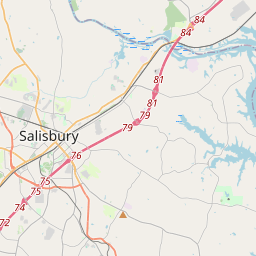Andrew Jackson
Historical marker location:
Salisbury, North Carolina
( Marker is at the intersection of S Main Street and W Fisher Street, on the left when traveling north on S Main Street.)
Marker installed: 1951







© OpenStreetMap contributors
Loading...
Searching for other points of interest within 3 miles of this location.The town of Saluda, North Carolina, is home to the steepest standard-gauge mainline railway grade in the United States, with a gradient of 4.7%.
About Rowan County
Rowan County Timeline
Rowan County, located in the state of North Carolina, has a rich and diverse history that dates back to the prehistoric era. The area was initially inhabited by Native American tribes, including the Catawba and Cherokee, who lived off the land and hunted in the region. European settlement began in the mid-18th century, when German and Scotch-Irish immigrants migrated to the area in search of fertile land.
In 1753, Rowan County was officially established by the colonial government of North Carolina. The county was named after Matthew Rowan, who was the acting governor at the time of its formation. During the American Revolution, Rowan County played a crucial role, with many of its residents joining the Continental Army to fight for independence. The area also saw significant military activity, including the Battle of Clapp's Mill in 1780.
In the 19th century, Rowan County experienced economic growth and prosperity. Agriculture, particularly cotton and tobacco, became the backbone of the county's economy. The growth of the railroad network in the region further fueled the county's development by connecting it to major markets and cities. However, the county also grappled with social and political challenges, particularly during the Civil War and Reconstruction era.
In the 20th century, Rowan County continued to evolve and adapt. The county experienced industrial growth with the establishment of textile mills, manufacturing plants, and furniture factories. It also became a hub for education and culture, with institutions like Catawba College and a thriving arts community. Today, Rowan County blends its rich history with modern amenities, offering a charming mix of small-town charm and urban convenience.
In 1753, Rowan County was officially established by the colonial government of North Carolina. The county was named after Matthew Rowan, who was the acting governor at the time of its formation. During the American Revolution, Rowan County played a crucial role, with many of its residents joining the Continental Army to fight for independence. The area also saw significant military activity, including the Battle of Clapp's Mill in 1780.
In the 19th century, Rowan County experienced economic growth and prosperity. Agriculture, particularly cotton and tobacco, became the backbone of the county's economy. The growth of the railroad network in the region further fueled the county's development by connecting it to major markets and cities. However, the county also grappled with social and political challenges, particularly during the Civil War and Reconstruction era.
In the 20th century, Rowan County continued to evolve and adapt. The county experienced industrial growth with the establishment of textile mills, manufacturing plants, and furniture factories. It also became a hub for education and culture, with institutions like Catawba College and a thriving arts community. Today, Rowan County blends its rich history with modern amenities, offering a charming mix of small-town charm and urban convenience.
Rowan County Timeline
This timeline provides a condensed summary of the historical journey of Rowan County, North Carolina.
- 1753 - Rowan County is formed from the western portion of Anson County.
- 1763 - Salisbury, the county seat, is officially established and becomes an important crossroads town.
- 1770s - Revolutionary War hostilities intensify in the region, with several notable battles and skirmishes taking place.
- 1785 - The University of North Carolina is established in Chapel Hill, with Rowan County providing financial support.
- 19th century - Rowan County experiences significant growth and development, with the establishment of many mills, factories, and the arrival of the railroad.
- 1839 - The North Carolina Railroad reaches Salisbury, further fueling the county's economic growth.
- 1861-1865 - Rowan County residents actively participate in the Civil War, with many joining Confederate forces.
- Late 1800s to early 1900s - Rowan County becomes known for its agricultural output, particularly in the cultivation of tobacco.
- 1942 - During World War II, the county's population booms due to the establishment of the Richard-Gebaur Air Force Base.
- Late 20th century - Rowan County experiences a decline in manufacturing and agriculture, with efforts made to diversify the economy.
- Present day - Rowan County continues to be a hub for commerce, education, and culture, with ongoing efforts to preserve its rich historical heritage.